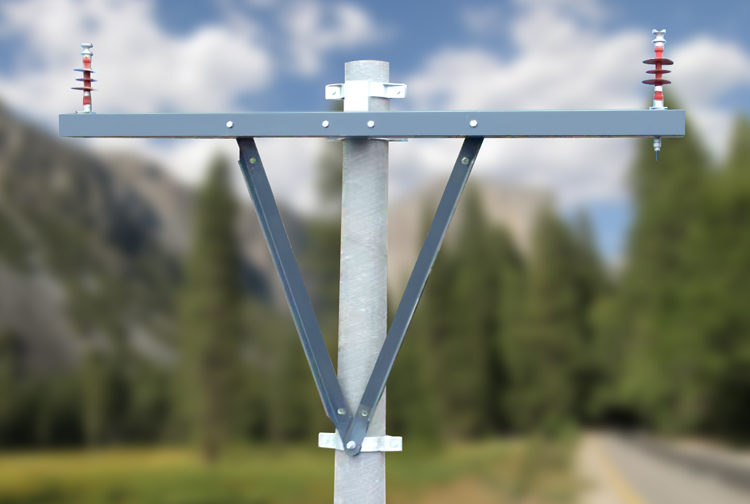
Fiberglass Crossarms
Crossarms, the horizontal beams attached to utility poles that support insulators and conductors, play a critical role in the electrical power distribution system. Traditionally, wood has been the primary material for crossarms. However, in recent years, fiberglass has emerged as a viable alternative, offering a unique set of properties and benefits. This article will delve into the comparative analysis of fiberglass and wood crossarms, highlighting their strengths and weaknesses to help you make an informed decision for your specific application.
Fiberglass Crossarms
Fiberglass crossarms are composite materials made from fiberglass fibers embedded in a resin matrix. They offer a combination of strength, durability, and electrical insulation, making them an excellent choice for a wide range of applications.
Advantages of Fiberglass Crossarms:
Lightweight: Fiberglass crossarms are significantly lighter than wood crossarms, reducing installation and maintenance costs.
High Strength-to-Weight Ratio: Fiberglass offers excellent strength-to-weight ratio, providing ample support for conductors while minimizing weight.
Electrical Insulation: Fiberglass is a non-conductive material, ensuring electrical safety. Dimensional Stability: Fiberglass crossarms are less susceptible to warping, cracking, and shrinking compared to wood.
Customization: Fiberglass crossarms can be customized to meet specific requirements, such as length, width, and hole patterns. Long Lifespan: With proper installation and maintenance, fiberglass crossarms can last for decades.
Disadvantages of Fiberglass Crossarms:
Installation Requirements: Specialized equipment and techniques may be required for installation.
Wood Crossarms
Wood crossarms, traditionally made from treated timber, have been used for many years in the utility industry.
Advantages of Wood Crossarms:
Natural Insulator: Wood is a natural insulator, providing electrical safety. Renewable Resource: Wood is a renewable resource, making it an environmentally friendly option.Disadvantages of Wood Crossarms:
Susceptibility to Rot and Decay: Wood is susceptible to rot, decay, and insect infestation, especially in humid environments.Maintenance Requirements: Wood crossarms require regular inspection and treatment to prevent decay and maintain structural integrity.
Limited Lifespan: The lifespan of wood crossarms is shorter compared to fiberglass crossarms.
Vulnerability to Fire: Wood is combustible, posing a fire hazard in certain applications.
Fiberglass vs. Wood: A Comparison
| Feature | Fiberglass Crossarms | Wood Crossarms |
| Corrosion Resistance | Excellent | Susceptible to rot and decay |
| Strength | High strength-to-weight ratio | Good strength, but can be affected by moisture and insects |
| Electrical Insulation | Excellent | Good natural insulator |
| Weight | Lightweight | Heavier |
| Maintenance | Low maintenance | Requires regular maintenance |
| Lifespan | Long | Shorter |
| Cost | Higher initial cost | Lower initial cost |
Choosing the Right Material
The choice between fiberglass and wood crossarms depends on several factors, including:
Environment: For harsh environments with high humidity or exposure to corrosive substances, fiberglass is the preferred choice.Budget: If initial cost is a major concern, wood crossarms may be a more affordable option.
Lifespan: For long-term durability, fiberglass crossarms offer a longer lifespan and lower maintenance costs.
Electrical Safety: Both materials provide good electrical insulation, but fiberglass offers superior resistance to moisture and environmental factors.
Sustainability: For environmentally conscious projects, wood crossarms sourced from sustainable forests may be a preferred option.
Conclusion
Fiberglass crossarms have emerged as a compelling alternative to traditional wood crossarms, offering superior performance in terms of durability, corrosion resistance, and electrical safety. While wood crossarms may be a more cost-effective initial choice, the long-term benefits of fiberglass crossarms, such as reduced maintenance and extended lifespan, make them a more sustainable and economical option in the long run.
Ultimately, the choice between fiberglass and wood crossarms depends on the specific requirements of the application. By carefully considering the factors discussed in this article, you can make an informed decision that ensures the safety, reliability, and longevity of your electrical infrastructure.
 +86 15303735673
+86 15303735673 Jessica@frpzs.com
Jessica@frpzs.com
 Technical Data
Technical Data











